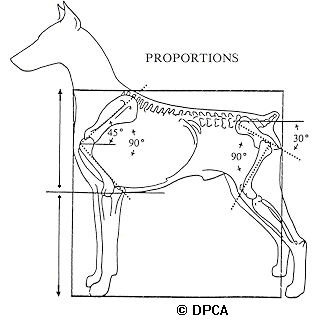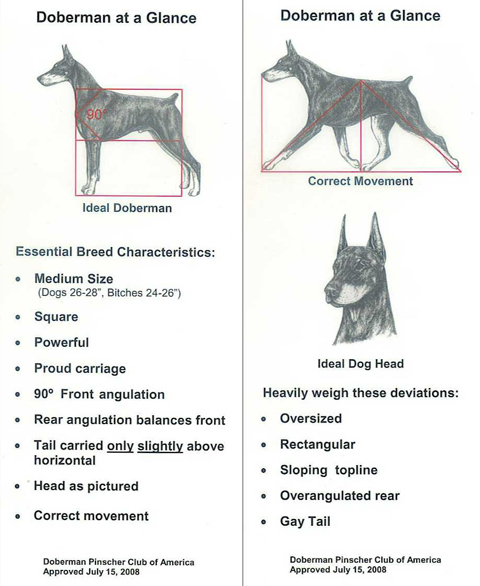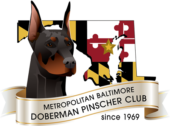
Official AKC Standard of the Doberman Pinscher
(Adopted February 6, 1982)
General Appearance
The appearance is that of a dog of medium size, with a body that is square. Compactly built, muscular and powerful, for great endurance and speed. Elegant in appearance, of proud carriage, reflecting great nobility and temperament. Energetic, watchful, determined, alert, fearless, loyal and obedient.
Size, Proportion, Substance
Height at the withers: Dogs 26 to 28 inches, ideal about 27 1/2 inches; Bitches 24 to 26 inches, ideal about 25 1/2 inches. The height, measured vertically from the ground to the highest point of the withers, equaling the length measured horizontally from the forechest to the rear projection of the upper thigh. Length of head, neck and legs in proportion to length and depth of body.
Head
Long and dry, resembling a blunt wedge in both frontal and profile views. When seen from the front, the head widens gradually toward the base of the ears in a practically unbroken line. Eyes almond shaped, moderately deep set, with vigorous, energetic expression. Iris, of uniform color, ranging from medium to darkest brown in black dogs; in reds, blues, and fawns the color of the iris blends with that of the markings, the darkest shade being preferable in every case. Ears normally cropped and carried erect. The upper attachment of the ear, when held erect, is on a level with the top of the skull.
Top of skull flat, turning with slight stop to bridge of muzzle, with muzzle line extending parallel to top line of skull. Cheeks flat and muscular. Nose solid black on black dogs, dark brown on red ones, dark gray on blue ones, dark tan on fawns. Lips lying close to jaws. Jaws full and powerful, well filled under the eyes.
Teeth strongly developed and white. Lower incisors upright and touching inside of upper incisors true scissors bite. 42 correctly placed teeth, 22 in the lower, 20 in the upper jaw. Distemper teeth shall not be penalized. Disqualifying Faults: Overshot more than 3/16 of an inch. Undershot more than 1/8 of an inch. Four or more missing teeth.
Neck, Topline, Body
Neck proudly carried, well muscled and dry. Well arched, with nape of neck widening gradually toward body. Length of neck proportioned to body and head. Withers pronounced and forming the highest point of the body. Back short, firm, of sufficient width, and muscular at the loins, extending in a straight line from withers to the slightly rounded croup.
Chest broad with forechest well defined. Ribs well sprung from the spine, but flattened in lower end to permit elbow clearance. Brisket reaching deep to the elbow. Belly well tucked up, extending in a curved line from the brisket. Loins wide and muscled. Hips broad and in proportion to body, breadth of hips being approximately equal to breadth of body at rib cage and shoulders. Tail docked at approximately second joint, appears to be a continuation of the spine, and is carried only slightly above the horizontal when the dog is alert.
Forequarters
Shoulder Blade sloping forward and downward at a 45-degree angle to the ground meets the upper arm at an angle of 90 degrees. Length of shoulder blade and upper arm are equal. Height from elbow to withers approximately equals height from ground to elbow. Legs seen from front and side, perfectly straight and parallel to each other from elbow to pastern; muscled and sinewy, with heavy bone. In normal pose and when gaiting, the elbows lie close to the brisket. Pasterns firm and almost perpendicular to the ground. Dewclaws may be removed. Feet well arched, compact, and catlike, turning neither in nor out.
Hindquarters
The angulation of the hindquarters balances that of the forequarters. Hip Bone falls away from spinal column at an angle of about 30 degrees, producing a slightly rounded, well filled-out croup. Upper Shanks at right angles to the hip bones, are long, wide, and well muscled on both sides of thigh, with clearly defined stifles. Upper and lower shanks are of equal length. While the dog is at rest, hock to heel is perpendicular to the ground. Viewed from the rear, the legs are straight, parallel to each other, and wide enough apart to fit in with a properly built body. Dewclaws, if any, are generally removed. Cat feet as on front legs, turning neither in nor out.
Coat
Smooth-haired, short, hard, thick and close lying. Invisible gray undercoat on neck permissible.
Color and Markings
Free, balanced and vigorous, with good reach in the forequarters and good driving power in the hindquarters. When trotting, there is strong rear-action drive. Each rear leg moves in line with the foreleg on the same side. Rear and front legs are thrown neither in nor out. Back remains strong and firm. When moving at a fast trot, a properly built dog will single-track.
Temperament
Energetic, watchful, determined alert, fearless, loyal and obedient. The judge shall dismiss from the ring any shy or vicious Doberman.
Shyness: A dog shall be judged fundamentally shy if, refusing to stand for examination, it shrinks away from the judge; if it fears an approach from the rear; if it shies at sudden and unusual noises to a marked degree.
Viciousness: A dog that attacks or attempts to attack either the judge or its handier, is definitely vicious. An aggressive or belligerent attitude towards other dogs shall not be deemed viciousness.
Faults
The foregoing description is that of the ideal Doberman Pinscher. Any deviation from the above described dog must be penalized to the extent of the deviation.
Disqualifications
Overshot more than 3/16 of an inch, undershot more than 1/8 of an inch. Four or more missing teeth. Dogs not of an allowed color.
The Doberman at a glance is NOT part of the Doberman standard. You can view the entire illustrated standard on the Judges Education Committee website here.

Copyright © 1997-2015 DPCA | reprinted with permission from DPCA
